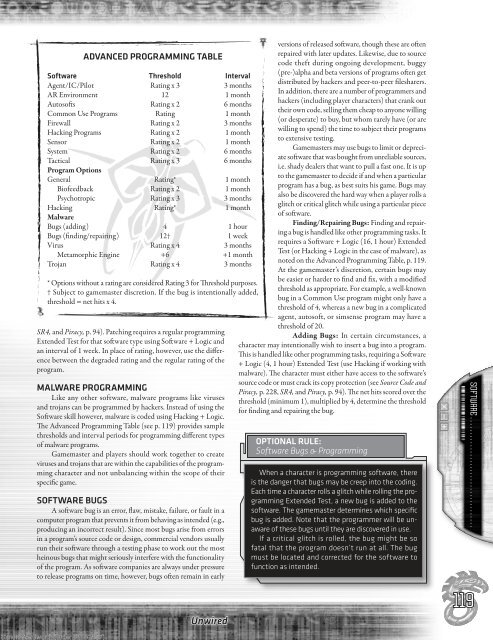comStar Firewall alert - PhaseThrough
comStar Firewall alert - PhaseThrough
comStar Firewall alert - PhaseThrough
Create successful ePaper yourself
Turn your PDF publications into a flip-book with our unique Google optimized e-Paper software.
advanced prograMMing taBLe<br />
Software threshold interval<br />
Agent/IC/Pilot Rating x 3 3 months<br />
AR Environment 12 1 month<br />
Autosofts Rating x 2 6 months<br />
Common Use Programs Rating 1 month<br />
<strong>Firewall</strong> Rating x 2 3 months<br />
Hacking Programs Rating x 2 1 month<br />
Sensor Rating x 2 1 month<br />
System Rating x 2 6 months<br />
Tactical Rating x 3 6 months<br />
Program Options<br />
General Rating* 1 month<br />
Biofeedback Rating x 2 1 month<br />
Psychotropic Rating x 3 3 months<br />
Hacking Rating* 1 month<br />
Malware<br />
Bugs (adding) 4 1 hour<br />
Bugs (finding/repairing) 12† 1 week<br />
Virus Rating x 4 3 months<br />
Metamorphic Engine +6 +1 month<br />
Trojan Rating x 4 3 months<br />
* Options without a rating are considered Rating 3 for Threshold purposes.<br />
† Subject to gamemaster discretion. If the bug is intentionally added,<br />
threshold = net hits x 4.<br />
SR4, and Piracy, p. 94). Patching requires a regular programming<br />
Extended Test for that software type using Software + Logic and<br />
an interval of 1 week. In place of rating, however, use the difference<br />
between the degraded rating and the regular rating of the<br />
program.<br />
MaLware prograMMing<br />
Like any other software, malware programs like viruses<br />
and trojans can be programmed by hackers. Instead of using the<br />
Software skill however, malware is coded using Hacking + Logic.<br />
The Advanced Programming Table (see p. 119) provides sample<br />
thresholds and interval periods for programming different types<br />
of malware programs.<br />
Gamemaster and players should work together to create<br />
viruses and trojans that are within the capabilities of the programming<br />
character and not unbalancing within the scope of their<br />
specific game.<br />
Software BUgS<br />
A software bug is an error, flaw, mistake, failure, or fault in a<br />
computer program that prevents it from behaving as intended (e.g.,<br />
producing an incorrect result). Since most bugs arise from errors<br />
in a program’s source code or design, commercial vendors usually<br />
run their software through a testing phase to work out the most<br />
heinous bugs that might seriously interfere with the functionality<br />
of the program. As software companies are always under pressure<br />
to release programs on time, however, bugs often remain in early<br />
Unwired<br />
versions of released software, though these are often<br />
repaired with later updates. Likewise, due to source<br />
code theft during ongoing development, buggy<br />
(pre-)alpha and beta versions of programs often get<br />
distributed by hackers and peer-to-peer filesharers.<br />
In addition, there are a number of programmers and<br />
hackers (including player characters) that crank out<br />
their own code, selling them cheap to anyone willing<br />
(or desperate) to buy, but whom rarely have (or are<br />
willing to spend) the time to subject their programs<br />
to extensive testing.<br />
Gamemasters may use bugs to limit or depreciate<br />
software that was bought from unreliable sources,<br />
i.e. shady dealers that want to pull a fast one. It is up<br />
to the gamemaster to decide if and when a particular<br />
program has a bug, as best suits his game. Bugs may<br />
also be discovered the hard way when a player rolls a<br />
glitch or critical glitch while using a particular piece<br />
of software.<br />
Finding/Repairing Bugs: Finding and repairing<br />
a bug is handled like other programming tasks. It<br />
requires a Software + Logic (16, 1 hour) Extended<br />
Test (or Hacking + Logic in the case of malware), as<br />
noted on the Advanced Programming Table, p. 119.<br />
At the gamemaster’s discretion, certain bugs may<br />
be easier or harder to find and fix, with a modified<br />
threshold as appropriate. For example, a well-known<br />
bug in a Common Use program might only have a<br />
threshold of 4, whereas a new bug in a complicated<br />
agent, autosoft, or simsense program may have a<br />
threshold of 20.<br />
Adding Bugs: In certain circumstances, a<br />
character may intentionally wish to insert a bug into a program.<br />
This is handled like other programming tasks, requiring a Software<br />
+ Logic (4, 1 hour) Extended Test (use Hacking if working with<br />
malware). The character must either have access to the software’s<br />
source code or must crack its copy protection (see Source Code and<br />
Piracy, p. 228, SR4, and Piracy, p. 94). The net hits scored over the<br />
threshold (minimum 1), multiplied by 4, determine the threshold<br />
for finding and repairing the bug.<br />
optionaL rULe:<br />
Software Bugs & Programming<br />
When a character is programming software, there<br />
is the danger that bugs may be creep into the coding.<br />
Each time a character rolls a glitch while rolling the programming<br />
Extended Test, a new bug is added to the<br />
software. The gamemaster determines which specific<br />
bug is added. Note that the programmer will be unaware<br />
of these bugs until they are discovered in use.<br />
If a critical glitch is rolled, the bug might be so<br />
fatal that the program doesn’t run at all. The bug<br />
must be located and corrected for the software to<br />
function as intended.<br />
Simon Wentworth (order #1132857) 9<br />
119<br />
software . . . . . . . . . . . . . . . . . . . . . . . . . . . . . . . . . . . .


